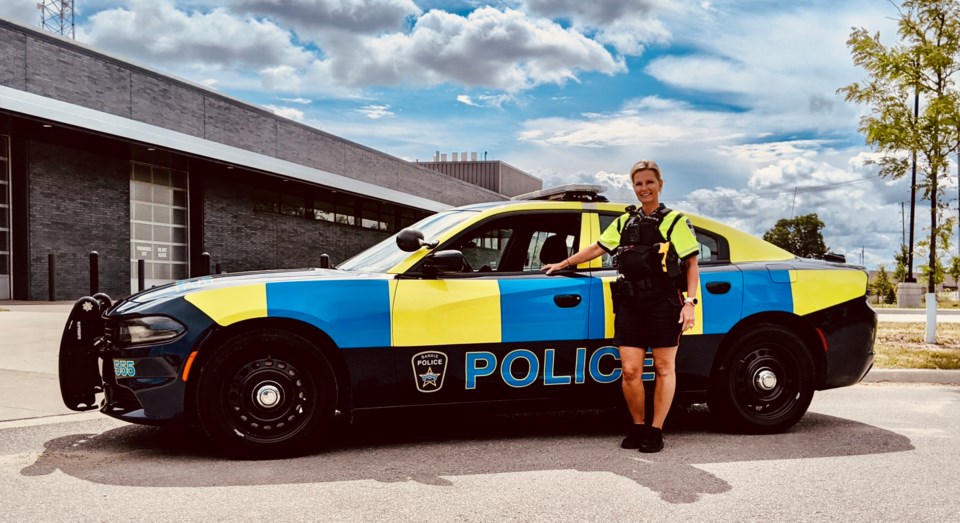You won’t have to look too hard for Barrie’s new police vehicles.
Next week, three checkerboard-designed cruisers, coloured blue and lime-green-yellow, also called half-Battenburg, will be operational on city streets — used by the Barrie Police Service community safety and well-being teams, along with the traffic unit.
“Police need to be visible, highly visible,” said Barrie Police Chief Kimberley Greenwood, as the vehicles were introduced this morning at the Fairview Road headquarters. “They need to attract the attention of motorists, but they also need to be able to quickly be identified as a police vehicle.”
Greenwood said lime-green-yellow is the most visible colour from a distance, as it reflects the most light, which means people see it first.
“While our officers are always out and about in our community, a more visible police vehicle can lead to an increase in the recognition of police presence, which leads to a deterrence effect and increased feelings of safety,” the chief said.
Barrie Deputy Police Chief Rich Johnston said the colourful cruisers are also safer for officers, because the visibility of police encourages lawful behaviour.
“We want you to see us and know we are there,” he said.
Johnston said the purpose behind exploring this type of design has always been about visibility and officer safety. Operating an emergency vehicle brings its own level of increased hazards, he said, and increasing citizens’ awareness of police presence is meant to help keep officers safer.
“It is about approachability and the ethos that we have as a public service,” he said. “It is meant to project the message that ‘here we are, we are here to help.’ How our community sees us does matter.”
Greenwood said there are reasons why the test vehicles include the so-called Battenburg pattern on just half of the car, and only on its sides.
“This design has been shown to be more visible in areas with lots of visual clutter, such as other cars, stores, houses, etc.,” she said. “Studies have shown that the side of the car is most seen by passing motorists. The front of the vehicle is only seen in the driver’s rear-view mirror.”
Greenwood said the test vehicles will be deployed in the community and any additional data on the public’s perception will be gathered by police.
As with any change in vehicle, a new design would be phased in as new vehicles are ordered according to the Barrie police department's budget, however the cost of conducting the survey and research is covered by a grant.
“The importance of ensuring police vehicles are visible can be seen in the potential improvements to not only perceptions of safety in our community, but also the physical safety of our members behind the wheel,” Greenwood said.
Several years ago, when Barrie police was changing from white to dark blue police cruisers, there was some concern from the community that the new cars were too difficult to distinguish from regular vehicles on Barrie streets.
“At no time were we trying to be discrete,” Greenwood said. “Not that we were ever accused of being stealth.”
Greenwood said that won’t be a concern with these vehicles, one Dodge Charger and two Ford Explorers.
“We hope that this will generate a lot of public discussion,” she said.
Depending on the feedback, the new design and colours could be phased in as Barrie police orders and receives new vehicles, Greenwood said.
Visibility of police vehicles was determined to be important in a recent public survey by Barrie police, with about 3,000 people offering opinions.
Launched in early June, and it asked respondents about their perception of, among other traits, visibility, trustworthiness and approachability of a variety of police vehicle designs.
The test car design cars were financed from the provincial community safety police grant.



